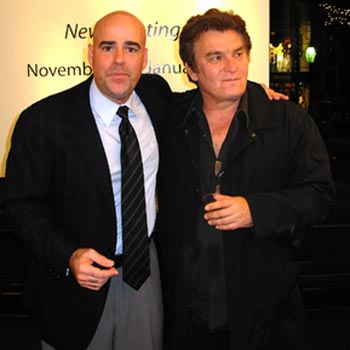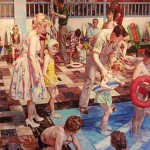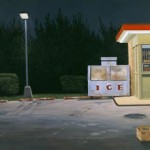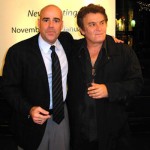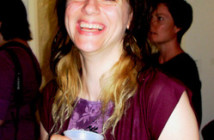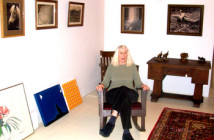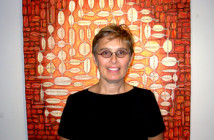Five years ago Tom Smith, who with his wife Becky Kidder, runs Kidder Smith Gallery hit Boston’s staid Newbury Street like a human tsunami. With an impeccable, neat as a pin, obsessively minimalist, high concept space it was evident from the get go that this was a very different persona and approach to the street. The word was that the clean headed Smith, he of the long lashed, dark and flashing, bedroom eyes planned to mostly show Post Pop, what he describes as the “soft porn of the art world” and slick abstractionists from California.
The first show sucked, big time, and I told him so. He explained out of the corner of his mouth that he had owed a favor. Because, at the time, he had no plans to show any local artists I also called him a Carpetbagger. To his face. Our relationship, so to speak, was off and running. Tom, it appears, thrives on adversity. He likes to turn it around and before you know it you are flat on the turf with his verbal foot on your throat. When he introduces me to friends and clients during visits to the gallery, he likes to repeat the “carpetbagger” riff. He has the memory of an elephant, heart of a lion, and fangs of a cobra. In short, he’s fun to know and a great sparring partner: although I am losing a step on my wheels and find it harder to go toe to toe with the kids.
Not that Tom is a kid. More like a yuppie. Often the dialogue about art and artists, business in general, or the latest series on HBO, bring on the Sopranos, he loves Ali G, can do all the shtick including the finger snaps, is more high concept than insight. But great fun to hang with as we did recently for a sit down, chin wag, and the usual beer and burger. He liked my pub and its $1.98 burger but prefers the $40 version at his own favorite hang. Tom’s a high ender. What they call a Whale in Vegas his favorite town in the US after Miami, NY and LA. He sees Boston as a great place to be in and out of. What he likes best is the proximity to the airport and easy access to the Vineyard in the summer. He describes the city as the second most expensive per square foot in the country. But, of course, he is describing the choicest cuts of the city. With truffles. My Boston, East Boston actually, closer to the airport, is, frankly, a lot cheaper. But we don’t surf the same turf. The rich are different from us, as F. Scott said.
But is Tom rich? Interesting question. Brought up middle class. Terrific salesman. Made a bundle. Has the Midas touch. Married well. (Doesn’t like to talk about it.) But is more of a made man at the crap table of life. As an art dealer he makes you an offer you cannot refuse. But most of the homes he visits in their well heeled social circle do not impress him with the art on the walls. Mostly gold frames and heirlooms. Safe and boring stuff bought at Vose and Childs galleries a few generations back when Homer was hot. He gets his action elsewhere from out of town clients.
He settled into the booth as I pulled a “Bluebook” out of my bag to take notes. I am a professor at Suffolk from which he is a “dropout,” although an article in the Martha’s Vineyard Times by Brooke Robards profiled him as a “graduate” and English Major. Tom, not one to hold back a good story, checked out the blue book which reminded him of an incident during his less than stellar stint as an undergraduate. During an exam he excused himself to take a leak and in the men’s room fished about in the trash for the fully loaded blue book stashed there by a better student and friend. But when Tom pulled it out someone had the nerve to empty Coke all over it. The exam book was soaked and unusable. Crestfallen, Tom returned to the class and wrote a C minus essay on Dante. Arguably, the perfect training for a future big time art dealer. Or, as Bill Gates, another dropout, would say “If I need a Ph.D. I’ll hire one.”
You get the sense that Tom has been flying from the seat of his pants and making it up as he goes along. But a lightning fast mind in the high stakes art world game of Texas hold em all in poker. Not that I am always smitten by what the gallery shows but he does it with duende as the late George Frazier would say. Yes, Tom has dunede. Ole.
So how did he get from there to here? Born in Brooklyn in 1963, the son of a Secret Service officer. The family moved around as happens with government workers. Ending in Boston where his father was bureau chief. Most of the time he was running forgers and credit card fraud. But occasionally he would suit up and pack heat when the President or some other chief of state was in town. Tom recalls meeting the Pope which was a big deal for a Catholic kid.
I asked if his dad had taught him how to handle a pistol? “I’m not a big gun guy,” he responded. “I did some shooting in a range in Vegas. They put up targets of Osama Bin Laden and Saddam Hussein. My dad’s weapon of choice was a 357 Magnum. There were four boys and we were a fairly close family. Dad had served in Korea and was very disciplined. The family dog of choice, for example, was a German Shepherd. My dad died ten years ago at the age of just 63. He retired early at 49 and that killed him. He went from a very active life to trying to find something to do. He did his 29 years and retired on 90% of his salary as a pension. But he regretted retiring.”
For the boys it was fun to have such a dad. There was a separate car parked in the back yard. A highly polished, black and blue, ’98 Oldsmobile, fully loaded with cop stuff. It was the backup car for the Vice President in the event of an emergency. It just sat in the drive way but the boys and their pals liked to play Secret Service in the vehicle. While he had rank and position the family was middle class. There were no toys in the house. At Christmas the usual gifts were books and his dad was an avid reader.
“I was on my own by 18, “he said. “I enjoy being alone. I like being with Tommy. I have to breakaway. I need to travel and have downtime. I enjoy having dinner by myself in a hotel. Although I am usually not alone very long because I am so charismatic.” He said that with a great playful grin. “Fifty percent of the time I travel solo. I just got back from LA. I love LA.”
Most of his business comes from national clients and contacts. He has lived in Boston for the past 25 years where he has family and friends. So he is rooted here but has nothing nice to say about trying to sell art to local clients. He has national clients who “don’t whine and complain about the price or demand discounts.” He has a nothing to loose approach to discussing the Boston art collectors, if any, who are mostly very conservative and low end. Bargain hunters and bottom feeders. His primary clients come from LA, Miami, NY, San Francisco and tend to buy works that start at $10,000. “Bostonians are tight with their money,” he said. “Show me a wealthy guy on Beacon Hill and you need a SWAT team to get the money out of them. They have a different attitude about spending their money. You go to their homes and it is all old inherited furniture and landscapes of Cape Cod.”
But he views Boston as a perfect city six months of the year. “I love the spring and fall,” he said. “And get me out in the summer and winter.”
Given the tough local climate for selling contemporary art how does the gallery survive? He states that he could make a good living showing safe stuff like a lot of other galleries on the street. But that would bore him. And, clearly, Tom likes a lot of stimulation. As to that “carpetbagger” riff it has not entirely proven to be true. Yes, he continues to show a lot of slick photography and California Pop but he has also taken chances with some of the best of Boston artists. He states that there are a lot of highly regarded local artist he might show but, “The opening would be mobbed with the backpackers and all their pals but bottom line, nothing sells.” Over the past few years, however, he has cherry picked some of the best established artists as they become available. On the night we met he was distressed to inform me that one of his favorite artists, Ralph Hamilton, included in the current group show, had passed away. Tom is very close to the artists he handles and Ralph was family.
“What sells,” he said, “Is a great ad in Art in America.” It is unheard of for a Boston gallery, only five years in business, to take full page monthly ads in at $6,000 a pop. That on top of $8,000 a month rent. He describes his nut as about $20,000 a month. Plus there was a costly build out and startup to overcome. “I would put money into Kidder Smith” he said with some modest pride. “We have a very solid and growing business.”
He has done well by taking chances on artists who had enjoyed just marginal success with other galleries. Miroslav Antic was one of the best artists in Boston when he left to live in Florida several years ago after decades of struggle. Since showing with Kidder Smith he has enjoyed national sales and increased prices. There is a NY show on the horizon and Tom is working on a venue in LA. He talks about starting to do catalogs in addition to ads. In April he will have his first show with David Moore, an abstract, stripe painter who has languished here so far. Tom is so sanguine on the work and its sales potential that he is launching the artist with a two page ad. Guess that’s more bang for the buck and it pays to advertise. That’s a very different strategy from other mid cap venues on the street.
When we got around to discussing the Kidder part of Kidder Smith he tightened up a lot. He and Becky, parents of a toddler, met when they were in sales for the Brookstone Company which sells high end appliances. After marrying in 1999 they owned Carrots Restaurant in posh Wellesley for four years. But art steadily emerged as their true passion. Becky inherited a share of the modernist works in the estate of her grandmother, Dottie Kidder, a friend and patron of artists including Alexander Calder, Joan Mitchell, Helen Frankenthaler and Robert Motherwell. It was handling this work that got them involved in collecting and for a couple of years they traveled extensively too sharpen their eye for contemporary art prior to launching the business. She continues to have an administrative involvement with the gallery. For the past two summers there was a gallery annex on Martha’s Vineyard in some family property. But Tom says that he does not plan to continue that venue although it held its own.
Clearly, the couple has deep pockets. But Tom is firm in stating that they do not have the attitude that comes with wealth and power. “We are not limousine liberals like Barbara Streisand and Michael Moore,” he said. “We treat people well including those who work for us. We respect people. We have never been entitled. If anything, we like to keep a low profile below the radar screen. Artists love being with us. We sell their work. If a show is up and it is near the end of the month if nothing has sold I feel terrible. But it is difficult to sell every show. You have to be Barnum and Bailey. Yeah, that ‘carpetbagger’ thing. That was your best line. But guess what. It is still hard to sell Boston artists. Great shows but no sales.”
Just how does he see the status of the gallery overall? “We’re a good gallery, not a great gallery,” he said. “We show work that is well executed. That sells for between $4,000 and $20,000. We handle artists with established resumes and solid exhibition track records. I am proud of all of our shows. We are handling three of what I view as the top five artists in Boston: David Moore, Peter Harris (photographer) and Miroslav (expatriate). Like Miro, if the work gets out there it will sell. He is an extremely talented painter, as well as a close personal friend.”
Just why is he abandoning the Vineyard gallery which was reaching a select, upscale, famous summer audience? Surely it was expanding the client base and reaching the right target audience. “The problem is staffing,” he said. “As well as running back and forth. I can’t be everywhere. When someone is writing a fat check they want the boss. Everyone wants their balls licked when they write a check.”
So a lot of the business is personal. He expressed concern when a client just shows up and makes an impulse purchase. “They have to ask the right questions,” he said. “They need to want to know about the artist. The resume and reviews. To not wake up and regret the decision. To feel comfortable with the work which looks great in their home and to show it off to their friends. We look for clients who trust and grow with us. There are individuals who have built strong collections and have spent several hundred thousand dollars.”
Apparently they are the kind of clients that are drawn in by splashy full page ads. It is a very different strategy from most galleries selling safe stuff to local clients. Not to say that Tom’s stable is edgy. Nobody is destined for the Whitney Biennial or documenta. There is nothing cutting edge about what he handles but it is solid mid cap work by established artists. Soon he will be testing the waters at the art fairs. Probably starting with Scope Miami. So he is getting antsy for the next level.
“I like action,” he said. “I go to Times Square to relax. To Vegas a couple of times a year and for the Super Bowl. LA, NY, Vegas, Miami. Boston is nice and cute. Where else can you spend $1,200 a square foot just to have a place to live?” But please don’t leave. We need the action. Tom puts the snap and crackle in the pop.
Links:
Kidder Smith Gallery
"American Painting" is on view March 1 - April 1, 2006 at Kidder Smith Gallery.
Smith image courtesy of the author.
All other images courtesy of the artist and Kidder Smith Gallery.

